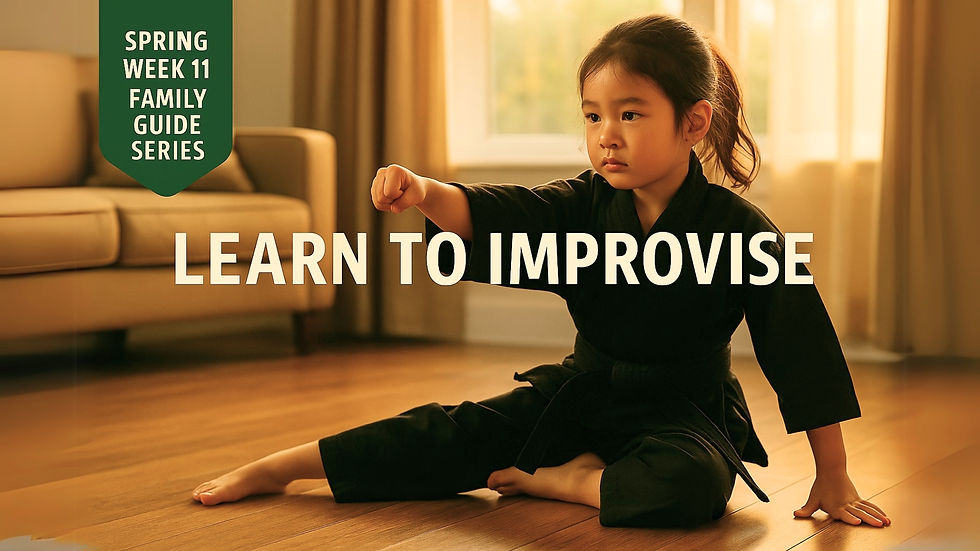Developing a Creative Mind Through Martial Arts
- Christopher Wilson

- Jun 9
- 4 min read

Whether it’s a martial artist rethinking a form, a parent reimagining bedtime routines, or a student trying a new way to solve a problem—innovation lives at the intersection of courage and curiosity. It’s not about being clever. It’s about being open.
Everything that improves starts with a question.
“Could this be better?” “What if we tried something different?”
At Kuk Sool Won™ Family Martial Arts in Sherman Oaks, we teach students to honor the wisdom of tradition—and to grow from it. As they develop discipline and skill, we also challenge them to explore new ways of thinking, learning, and leading. In both martial arts and family life, innovation is the key to meaningful, lasting improvement.

Three Keys to Innovation
1. Think Beyond the Pattern
In martial arts, students learn forms—structured patterns of movement passed down through generations. But true mastery comes when we begin to ask:
“Why is this done this way?” “Could there be another approach?”
Innovation begins with curiosity. When students question assumptions or approach challenges creatively, they open new paths for growth. The same is true at home: patterns become ruts when we stop asking if they still serve us.
For kids in martial arts, the ability to think critically and creatively transforms how they learn—not just in the dojang, but in school and life.
Reflection moment:
What’s one routine you could reexamine this week — and improve with a small shift in mindset?

2. Adapt to Improve
Innovation often comes disguised as a setback. A missed target. A failed attempt. A moment where the old way just doesn’t work anymore.
But that’s exactly where innovation lives — in the willingness to adjust.
“I’ve missed more than 9,000 shots in my career. I’ve lost almost 300 games… I’ve failed over and over and over again in my life. And that is why I succeed.” —- Michael Jordan
Great martial artists adapt their techniques based on their body type, timing, or opponent. Families do the same when they shift communication styles or invent new ways to stay connected. Growth doesn’t require perfection — it requires responsiveness.
Families who train with us in Sherman Oaks often say the most important lessons happen outside the dojang—during problem-solving moments at home.

Try This:
The next time something doesn’t work, instead of giving up, ask:
“How can I use what I learned in martial arts today to approach this differently?” “What insight is this challenge trying to teach me—and what’s a new way I might respond?”

3. Learn to improvise
Innovation is not random; it becomes meaningful when it meets a need, solves a problem, or inspires someone else. When students create new training drills or reframe a challenge as a game, they are not just being clever—they are practicing leadership and learning to improvise.
At home, innovation might look like inventing a new family routine that works better than the old one. Or changing how you give feedback so your child hears it in a way that builds confidence.
Key Reminder:
The goal isn’t to be novel. It’s to be helpful and intentional.
“Innovation is seeing what everybody has seen and thinking what nobody has thought.”
— Dr. Albert Szent-Györgyi
Recommended Resources
Book Pick: The Innovator’s DNA
by Jeff Dyer, Hal Gregersen, and Clayton Christensen
This guide identifies five essential skills of innovators: associating, questioning, observing, networking, and experimenting — all of which align beautifully with martial arts practice and family leadership.
Creativity Toolbox for Students
Looking to help your child become more creative and confident in problem-solving?
Check out Edutopia’s free guide featuring tools like idea mapping, journaling, and creative thinking activities:
You can also try creativity mapping at home: Have your child draw or design a “better way” to do something ordinary — then try it together and reflect on the experience.
Real-Life Applications of Innovation
In the Dojang
Students at our Sherman Oaks martial arts school often explore alternate routines, adapt self-defense combinations, or demonstrate creative combinations with a partner. These experiences not only build technique—they develop leadership and confidence.
At Home
Turn an ordinary evening into a “Family Innovation Lab.” Invite each family member to present one creative solution to a common challenge—like bedtime, homework flow, or shared chores. Vote on one idea to implement for the week, then celebrate your experiment with a reflection night: What did we notice? Would we keep it, tweak it, or try something else next?
At School or Work
Help your child apply martial arts principles—like discipline, perseverance, and adaptability—to academic or social challenges. Every obstacle is a chance to innovate.

Master’s Insight
INNOVATION COMES FROM COURAGE, CURIOSITY, AND A COMMITMENT TO IMPROVEMENT.
Listen to the Podcast
The Family Guide is featured in audio form on our podcast. Listen together as a family or share with a friend and deepen the discussion on what it means to innovate in your daily life and training.
“Want to hear more? The Family Guide is featured on the WILLSONG Family Podcast — where family and leadership take root.”
Members Only
Additional resources, including the full Family Guide PDF and weekly Flashard, are available to Members Only. Join us to access the complete WILLSONG Family Leadership collection. ALL IN!
“Let’s keep growing — together.”





Comments